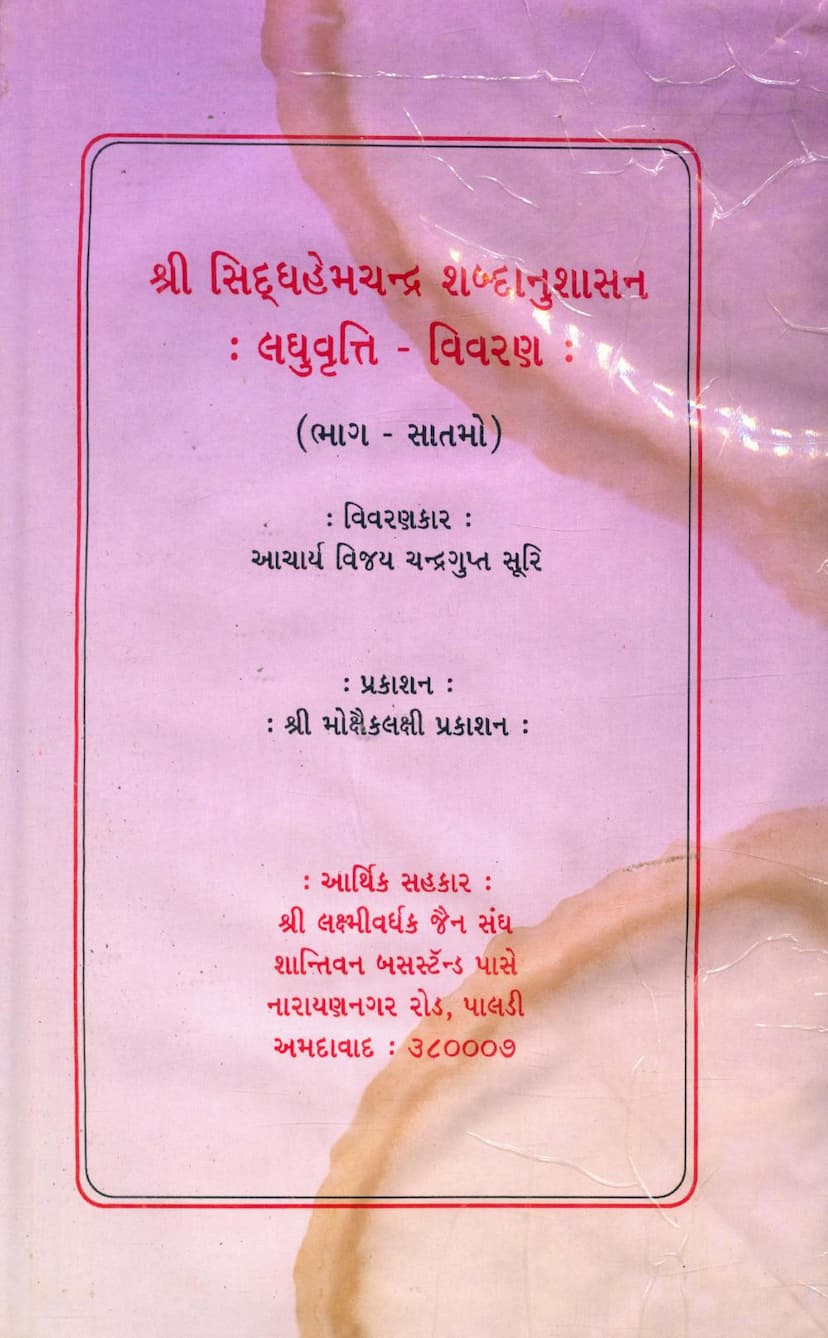Siddhhemchandra Shabdanushasan Laghuvrutti Vivran Part 07
Added to library: September 2, 2025

Summary
The provided text is Volume 7 of the "Laghuvritti Vivaran" (a commentary) on Hemachandracharya's "Siddhhemchandra Shabdanushasan" (a grammar of Sanskrit and Prakrit). The commentary is authored by Acharya Vijay Chandragupt Suri. This particular volume, Part 7, continues the detailed explanation of grammatical rules, likely focusing on the tad (स) suffixes and their application according to Panini's grammar as interpreted and presented within the Jain tradition.
Based on the scanned pages, the content is highly technical and deals with the intricacies of Sanskrit grammar, specifically the formation of words through suffixes. Here's a breakdown of the likely content based on the text and common patterns in such commentaries:
Overall Structure and Content:
- Commentary on Hemachandracharya's Grammar: The book is a commentary on a foundational Jain text on grammar, which itself is based on the renowned Sanskrit grammar of Hemachandracharya. Jain scholars often produced extensive commentaries to explain, elaborate, and sometimes adapt these grammatical principles within their philosophical and linguistic framework.
- Focus on Suffixes (Pratyaya): The text systematically analyzes various grammatical suffixes (प्रत्यय - pratyaya) that are added to root words to derive new words. The volume appears to cover specific categories of these suffixes.
- Detailed Grammatical Analysis: For each sutra (rule) being explained, the commentary likely includes:
- The original sutra from Hemachandracharya's work.
- The explanation of the sutra's meaning and purpose by Acharya Vijay Chandragupt Suri.
- Detailed grammatical derivations (vyutpatti - व्युत्पत्ति) of example words, showing how the rules apply step-by-step. This involves identifying root words, the relevant suffixes, applying rules for vowel changes (vriddhi - वृद्धि), elision (lopa - लोप), etc.
- Examples illustrating the application of the rules.
- Discussions of exceptions, special cases, and the rationale behind specific rules.
- Jain Context: While the grammar is primarily Sanskrit, the commentary is by a Jain Acharya, suggesting it might highlight specific interpretations or examples relevant to Jain philosophy, literature, or the Jain understanding of language.
Specific Grammatical Concepts Likely Covered (Based on page content):
The pages show discussions of several tad (तद्धित - taddhita) suffixes, which are generally added to nouns to form other nouns or adjectives. Some key concepts and rules evident from the text include:
- Definition of Taddhita: The commentary begins by defining Taddhita suffixes, stating that certain suffixes like san (सन्) are given the name taddhita by the rule (likely referring to an earlier sutra).
- Rules for Suffixes (e.g., san - सन्): The text explains how suffixes like san are applied to derive words indicating "offspring" or "descendants."
- Rules for Deriving Terms like "Vriddha" (वृद्ध): Rules are explained for deriving terms like vriddha (वृद्ध - meaning an elder descendant, like a grandson or great-grandson). This involves specific rules for descendants from the original ancestor, distinguishing between direct offspring and later generations. The rules mention terms like pautra (पौलत्र - grandson) and prapautra (प्रपौत्र - great-grandson).
- Rules for "Yuva" (युवा): The text discusses rules for forming terms indicating younger descendants, such as yuva (युवा - young descendant). These rules are often dependent on the survival of elder relatives.
- Rules for "Sapinda" (सपिण्ड): The concept of sapinda (related through shared body particles, a lineage term) is introduced, and rules are explained for forming terms based on sapinda relationships.
- Rules for Specific Terms (e.g., Devadatta, Amragupta, Purush, Stri): The commentary illustrates grammatical rules with specific examples derived from common Sanskrit names or terms like purusha (पुरुष - man) and stri (स्त्री - woman).
- Rules for Place Names: Some rules deal with deriving words related to place names, indicating origin or residence in a particular location.
- Rules for "Gotra" (गोत्र): Several rules are likely related to the formation of gotra names (lineage names derived from sages or ancestors).
- Rules for "Vriksha" (वृक्ष) and other Nouns: The text seems to cover rules related to derived terms from names of trees and other common nouns.
- Rules for "Nadi" (नदी - River Names): There are mentions of rules related to feminine nouns, potentially including river names.
- Rules for "Shaka" (शाका - Vegetables/Plants): Some rules may apply to words denoting plants or vegetables.
- Rules for "Mala" (माला - Garland): The text may also cover rules related to words denoting garlands or collections.
- Rules for "Bhava" (भाव - State/Essence): The commentary likely discusses suffixes used to denote abstract qualities or states.
Significance:
Such commentaries are crucial for understanding the nuances of Sanskrit grammar as applied in the Jain tradition. They provide a detailed linguistic framework for interpreting Jain scriptures and literature, ensuring the accurate understanding of terms and concepts. Acharya Vijay Chandragupt Suri's work is valuable for its comprehensive and detailed explanations.
In essence, this volume is a scholarly work dedicated to the meticulous analysis and explanation of Sanskrit grammatical rules related to word formation, specifically focusing on taddhita suffixes, within the context of Jain scholarship.